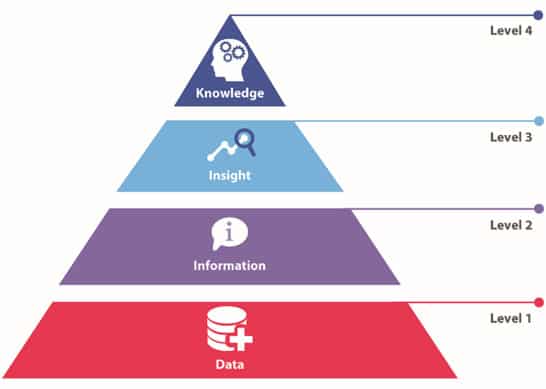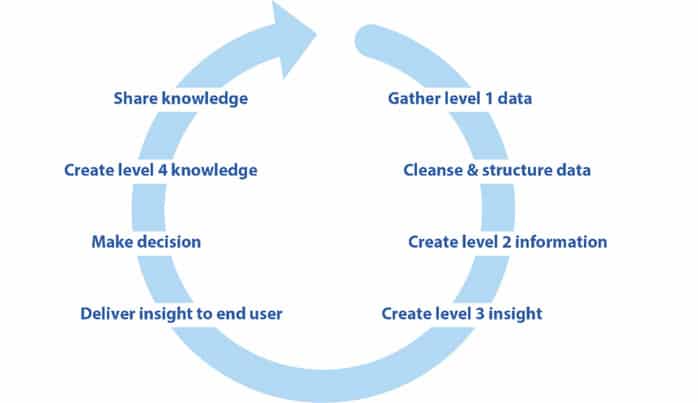Data Analytics and the Ring of Knowledge

Data analytics is rapidly becoming a critical field for all businesses. But in this cacophony of commentary around Big Data, Artificial Intelligence, Internet of Things, Cloud, and mobile, how do you decide where to spend your efforts?
As a business leader, what is it that you need to know? Also, what is the mind+machine approach and how can it help you?
Allow me to run you through three basic concepts you
should know before you embark on your data analytics adventure.
- Use cases
A use case is an end-to-end analytics support solution applied once or repeatedly to a single business issue faced by an end user or a homogenous group of end users who need to make decisions, take action, or deliver a product or service on time based on the insight delivered.
A use case can be very simple or incredibly complex. I have seen use cases based on a mere 800 bits and others that use hundreds of gigabytes of data. They can be focused on creating solutions for festering business problems or the development of new strategies. An example of a use case could be a solution that analyzes customer data to improve understanding of customer churn.
The use case concept can help you in several ways. Most importantly, it can improve your ROI. Dividing analytics investment by business issues faced by a single end user (or a homogenous group) allows the end user to set the business case behind the use case, thereby guiding on what should be included in the minimum viable product. It helps avoid overspending on nice-to-haves and allows you to define investment, and thus the ROI for each user case.
Managing your data analytics requirements on the back of use cases can also facilitate other aspects of your analytics value chain, such as knowledge and risk management, and compliance. However, even if you all you do is to use this approach to resolve one business issue at a time, it will allow you to capture the RoI and most probably improve your returns.
- Pyramid of use cases
The next basic concept that you need to understand is the pyramid of use cases.
Data is merely the raw material or input for the analytics value chain. The pyramid of use cases describes the different stages that data goes through before it is distilled into usable knowledge.
Level 1 – Data: Comprises raw or cleansed data, basically a collection of facts without any further analysis. Data has no direct value for a decision maker and often requires smart tools to process it. An example of data could be a sequence of measurements sent from a sensor in a packaging machine.
Level 2 – Information: Refers to data that has been processed to an extent and put in context. However, level 2 still doesn’t suffice as a basis for critical business decisions. An example of this level is the discovery that the sequence of measurements sent from the sensor has five unexpected outliers, which show that the packaging machine’s vibrations are stronger than allowed by technical specifications.
Level 3 – Insight: Insight is what the decision maker wants. It provides the necessary “so-what” to make value-adding decisions. To follow the previous example, insight would refer to a realization that the vibrations are stronger when the machine is run with a lower than specified load.
Level 4 – Knowledge: This level is the essence of what analytics, and indeed research, should aim for – insights that have been made re-usable over time, allowing others to make successful business decisions. In our example, this level would allow an update of the packaging machine’s guidance to increase the minimum load weight to avoid unwanted vibrations in it.
As we move from data toward knowledge, the volume of data goes down, with millions of individual records (data) being distilled to a simple line of advice or guidance (knowledge). Hence the pyramid analogy. For decision-makers, only the compressed insight or the knowledge are of value.
- Ring of knowledge
The analytics value chain can be broken down into eight key steps. The value is largely created in the last few steps, when the decision is made, while most of the effort and cost is incurred at the beginning of the analytics cycle – I call this the ring of knowledge.
Let me quickly run you through the ring of knowledge and briefly describe what happens at each stage:
- Steps 1 and 2: These steps involve the collection and cleaning of raw data, which currently relies heavily on machines. APIs can collect and process large quantities of data at a much faster pace than any data scientist can. Not only are machines faster, they are also more or less error free, making the data being fed into step 3 vastly more reliable.
- Step 3: In this step, the data is transformed into information. In other words, it is put into context and some initial patterns discovered. Recently, machines have begun playing a bigger role in information creation.
- Step 4: Creating insight is about isolating the so-what from the information. It requires the human brain’s perceptive power and capacity for lateral thinking. Even the cleverest artificial intelligence run tools aren’t able to assist with this step yet.
- Steps 5 and 6: The value of data analytics is lost if the right insight doesn’t reach the right decision maker at the right time. Smart tools, such as mobile apps and push notifications can assist with this process. However, when it comes to the resulting decision, human experience and instinct becomes critical.
- Steps 7 and 8: Finally, when it comes to creating knowledge, it requires the human mind to crystalize long-term learnings. Storage and distribution of this knowledge can be significantly supported by a sophisticated knowledge management platform.
The mind+machine impact
Consider this statement: ‘The fundamental purpose of data analytics is to support business decisions with facts and insights.’
While there is nothing wrong with the statement, it oversimplifies the issue. In order for a new analytics use case to be successful, the right decision maker (1) needs to receive the right insight (2) in the right format (3) and at the right time (4). Unless all these four conditions are met, the impact and ROI of an analytics use case is likely to be minimized.
Data analytics should be a strong enabler for business leaders. Yet many organizations struggle to achieve the desired results. The problem lies in the balance between mind and machine. Mind-only analytics, where humans do all the work, is too slow and costly, while machine-only analytics rarely delivers the insights needed.
Don’t believe the hype – Artificial Intelligence tools are not yet clever enough to deliver true insight without human support.
I believe a marriage of the perceptive power of the human mind with the benefits of automation is vital, because neither the mind nor machines alone can handle the complexities of analytics. This becomes clearer in view of the ring of knowledge – steps 1 and 2 are mostly machine-led, and technology is becoming better at the job every day. Machines have also been moderately successful at creating information from data in step 3. However, the human mind is indispensable for steps 4 to 7, because even the cleverest artificial intelligence tools can’t achieve the right results on these steps.
Machines can process great volumes of data far more efficiently and effectively than humans can, but the ability to spot and react to new patterns, understand the broader business context, differentiate between correlations and root-cause relationships, and tell machines what to do next will continue to be fundamentally human tasks, at least in the foreseeable future.
While I appreciate that there is a lot more to know about data analytics, I hope these few paragraphs give a better understanding of how you should approach any investment in data analytics. Just remember to attack one business issue at a time, always deliver the right insight to the right person at the right time, and make use of both mind+machine.
Add CEOWORLD magazine to your Google News feed.
Follow CEOWORLD magazine headlines on: Google News, LinkedIn, Twitter, and Facebook.
This report/news/ranking/statistics has been prepared only for general guidance on matters of interest and does not constitute professional advice. You should not act upon the information contained in this publication without obtaining specific professional advice. No representation or warranty (express or implied) is given as to the accuracy or completeness of the information contained in this publication, and, to the extent permitted by law, CEOWORLD magazine does not accept or assume any liability, responsibility or duty of care for any consequences of you or anyone else acting, or refraining to act, in reliance on the information contained in this publication or for any decision based on it.
Copyright 2024 The CEOWORLD magazine. All rights reserved. This material (and any extract from it) must not be copied, redistributed or placed on any website, without CEOWORLD magazine' prior written consent. For media queries, please contact: info@ceoworld.biz
SUBSCRIBE NEWSLETTER










